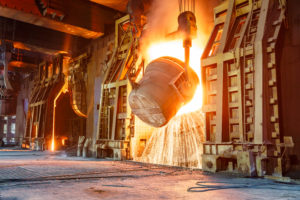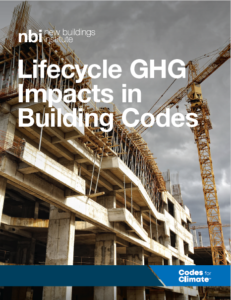Over the past 15 years, many jurisdictions have reduced operational emissions in buildings through policies focused on energy efficiency, resulting in lower energy bills, better indoor air quality, and increased comfort. As the carbon emissions associated with operating buildings continues to decrease, reducing the embodied carbon of buildings is the next big challenge. We know it must be if we are going to keep temperature rise below 1.5 degrees Celsius and prevent the worst impacts of climate change.
Embodied carbon, or the total greenhouse gas (GHG) emissions associated with building materials from extraction through end-of-life and disposal/reuse, makes up more than 11% of global emissions. Embodied carbon emissions are not part of the energy efficiency regulated by the energy code. However, there has been a wave of embodied carbon actions at the local, state, and federal levels—most recently an allocation of many billions of dollars in the Inflation Reduction Act (IRA) of 2022 for federal procurement and industry support of low-carbon building products.

With light being shone on the lifecycle impacts of building products, consumers—including government purchasers—are requesting manufacturers to share product information and deliver low-embodied carbon solutions. Procurement policies (also known as “Buy Clean” policies) are springing up across the county. Momentum is building for embodied carbon policies and initiatives that will make low-embodied carbon products one of the fastest growing markets of the next decade.
Addressing embodied carbon in codes
The U.S. does not have a national building code that can require low-carbon building products in private construction. Most U.S. states and some cities refer to the model code published by the International Code Council (ICC) when developing local requirements for their building codes. The ICC updates the suite of codes every three years—often referred to as a “code cycle.” With just one code development cycle taking us to 2025, and only three to reach 2030, the provisions adopted into the 2024 codes are critical to achieving the model codes we need to carry us into the next decade.
Since our inception, New Buildings Institute (NBI) has engaged with code-making bodies such as the ICC, proposing solutions that drive down energy use, and more recently carbon emissions, in buildings. Because the ICC is responsible for developing the International Building Code (IBC), which has primary domain over building materials, we were sure to be at the table when the code development process for the 2024 IBC kicked off in January.
Because of our efforts and those of our partners, for the first time ever, the topic of embodied carbon was debated by the ICC membership for inclusion in the IBC. By being an active participant in the 2024 IBC, NBI provided the IBC membership the chance to minimize the environmental impacts of the building materials with the highest emissions: concrete and steel. (Together, concrete and steel emissions typically account for 50% of total material emissions in commercial projects.) Read more about why embodied carbon matters.

During the 2024 IBC code development process, NBI and our partners submitted a proposal that concrete and steel be regulated within the building code. As written, the NBI embodied carbon IBC proposal requires concrete and steel products to meet specific global warming potential (GWP) limits and carbon impact disclosure through environmental product declarations (EPDs) for masonry, glass, and wood products.
The proposal was debated at a March 2022 ICC hearing, where representatives from various product manufacturer associations showed vigorous opposition. The committee voted the proposal down, citing several reasons, including: most products already comply; the code should not address the means and methods of construction; and cost of implementation. Finally, the committee admitted, “we’re not ready for this.” Unfortunately, there was no discussion about these specific concerns and therefore no way for NBI to weigh in on the outcome.
Hearing the apprehension from the opposition and from the committee, we revised the proposals. We added new exceptions to the requirements, which would apply only to projects of 50,000 square feet that use a large amount of concrete or steel. We were prepared to present the modifications at the public comment hearing for the IBC, held September 14 to 21 in Louisville, KY. However, the membership voted not to hear or consider the revised proposals.
Unfortunately, because the 2024 IBC chose not to address embodied carbon, the U.S. will continue to have a patchwork of local policies for reducing emissions from building products.
Making progress outside of the IBC

NBI’s pursuit of building codes to address embodied carbon is not over. While the IBC may not be ready to include embodied carbon requirements in the national model code, jurisdictions are ready. We continue to assist many jurisdictions interested in using building codes and policies to address embodied carbon. One key resource: Lifecycle GHG Impacts in Building Codes, presents language to incorporate embodied carbon requirements in building codes.
Several actions are underway that could change the way embodied carbon is addressed. A work group is proposing an embodied carbon approach for the ASHRAE 189.1, Standard for the Design of High-Performance, Green Buildings, which is adopted as the International Green Conservation Code. Addendum Z was recently voted for public comment, which sets mandatory disclosure of carbon impacts through EPD submittals on multiple building products. A second addendum is pending at ASHRAE 189.1 that could be released for public comment by the end of the year that sets mandatory GWP limits for building products.
Meanwhile, the CalGreen Carbon Reduction Collaborative run by the California Building Standards Commission, the Division of the State Architect, and the Department of Housing and Community Development, is proposing a required embodied carbon approach for CalGreen 2025. If approved, this would be the first state-wide code to address embodied carbon.
Federal funding for embodied carbon efforts will spur growth
The Inflation Reduction Act (IRA) of 2022 was the single-most significant piece of climate legislation ever passed by the U.S. Congress. One key component of the law made huge strides to support lowering the carbon impacts of industrial products used in the U.S., many of which go into building construction. The federal government will make a large investment in the development and procurement of low-carbon building materials and products, including using the massive purchasing power of the U.S. government itself. It also allocates $350 million to support the development of a product carbon labeling program and EPD development support for manufacturers. This is critical for jurisdictions looking to require EPDs. The IRA requirements and billions in funding support are driving national industries to lower-carbon building product outcomes.
With no standardization on low-embodied carbon building specifications, the U.S could fall behind the rest of the world in job creation and markets for emerging low-embodied carbon products. Through the 2024 IBC development process, we learned a lot from product manufacturers, policymakers, and sustainable building advocates about what is needed to progress embodied carbon policies nationally. While embodied carbon was ultimately left out of the 2024 model code, the IRA and the exciting work of many cities and states will encourage significant growth for low-embodied carbon building products over the next several years.
by Webly Bowles, Project Manager

Bio
Did you enjoy this content? Consider supporting NBI’s work with a donation today.
